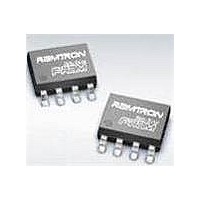FM24CL64-G Ramtron, FM24CL64-G Datasheet - Page 3

FM24CL64-G
Manufacturer Part Number
FM24CL64-G
Description
F-RAM 64K (8Kx8) 2.7V
Manufacturer
Ramtron
Datasheet
1.FM24CL64-G.pdf
(13 pages)
Specifications of FM24CL64-G
Memory Size
64 KB
Organization
8 K x 8
Interface
2-Wire
Operating Supply Voltage
2.7 V to 3.6 V
Operating Temperature Range
- 40 C to + 85 C
Package / Case
SOIC-8
Mounting Style
SMD/SMT
Lead Free Status / Rohs Status
Details
Available stocks
Company
Part Number
Manufacturer
Quantity
Price
Part Number:
FM24CL64-G
Manufacturer:
RAMTRON
Quantity:
20 000
Company:
Part Number:
FM24CL64-GTR
Manufacturer:
ramtron
Quantity:
10 000
Part Number:
FM24CL64-GTR
Manufacturer:
RAMTROM
Quantity:
20 000
Overview
The FM24CL64 is a serial F-RAM memory. The
memory array is logically organized as a 8,192 x 8 bit
memory array and is accessed using an industry
standard two-wire interface. Functional operation of
the F-RAM is similar to serial EEPROMs. The major
difference between the FM24CL64 and a serial
EEPROM with the same pinout relates to its superior
write performance.
Memory Architecture
When accessing the FM24CL64, the user addresses
8,192 locations each with 8 data bits. These data bits
are shifted serially. The 8,192 addresses are accessed
using the two-wire protocol, which includes a slave
address (to distinguish other non-memory devices),
and an extended 16-bit address. Only the lower 13
bits are used by the decoder for accessing the
memory. The upper three address bits should be set
to 0 for compatibility with larger devices in the
future.
The access time for memory operation is essentially
zero beyond the time needed for the serial protocol.
That is, the memory is read or written at the speed of
the two-wire bus. Unlike an EEPROM, it is not
necessary to poll the device for a ready condition
since writes occur at bus speed. That is, by the time a
new bus transaction can be shifted into the part, a
write operation will be complete. This is explained in
more detail in the interface section below.
Users expect several obvious system benefits from
the FM24CL64 due to its fast write cycle and high
endurance as compared with EEPROM. However
there are less obvious benefits as well. For example
in a high noise environment, the fast-write operation
is less susceptible to corruption than an EEPROM
since it is completed quickly. By contrast, an
EEPROM
vulnerable to noise during much of the cycle.
Note that it is the user’s responsibility to ensure that
V
incorrect operation.
Rev. 3.4
Feb. 2011
DD
is within datasheet tolerances to prevent
requiring
milliseconds
to
write
is
Two-wire Interface
The FM24CL64 employs a bi-directional two-wire
bus protocol using few pins or board space. Figure 2
illustrates a typical system configuration using the
FM24CL64 in a microcontroller-based system. The
industry standard two-wire bus is familiar to many
users but is described in this section.
By convention, any device that is sending data onto
the bus is the transmitter while the target device for
this data is the receiver. The device that is controlling
the bus is the master. The master is responsible for
generating the clock signal for all operations. Any
device on the bus that is being controlled is a slave.
The FM24CL64 always is a slave device.
The bus protocol is controlled by transition states in
the SDA and SCL signals. There are four conditions
including start, stop, data bit, or acknowledge. Figure
3 illustrates the signal conditions that specify the four
states. Detailed timing diagrams are in the electrical
specifications.
Microcontroller
Figure 2. Typical System Configuration
A0 A1 A2
SDA
FM24CL64
SCL
Rmax = tR/Cbus
A0 A1 A2
SDA
FM24CL64
Rmin = 1.1 KΩ
FM24CL64
SCL
Page 3 of 13
VDD












